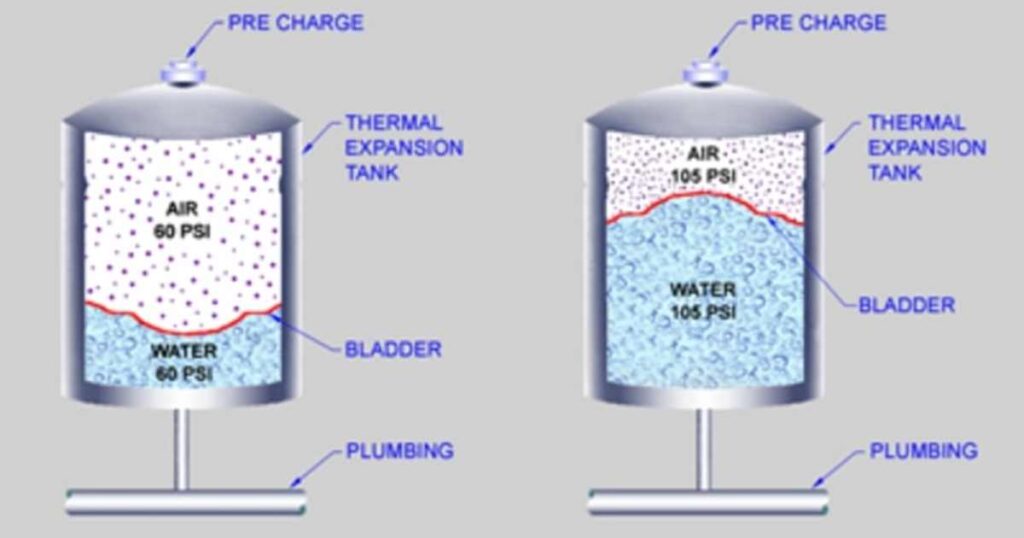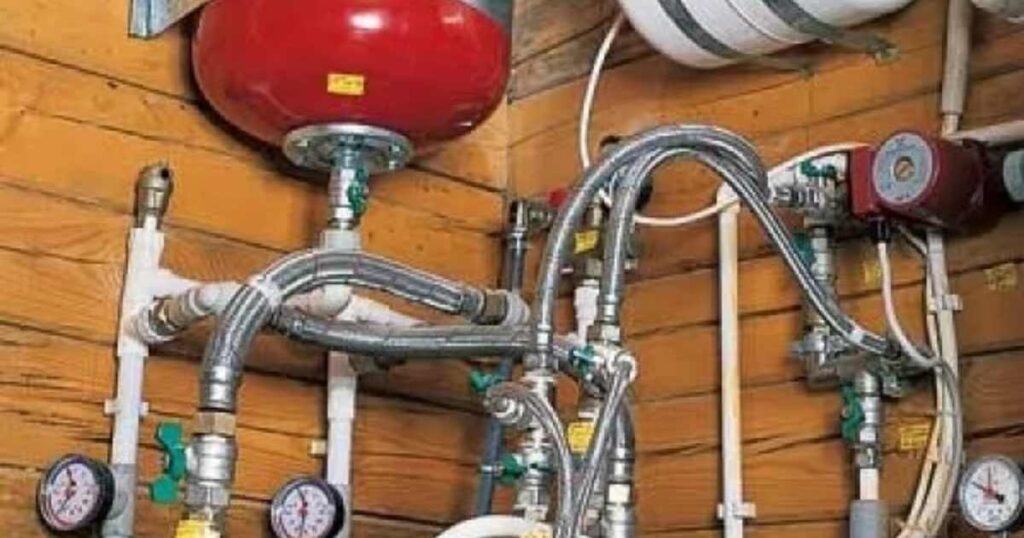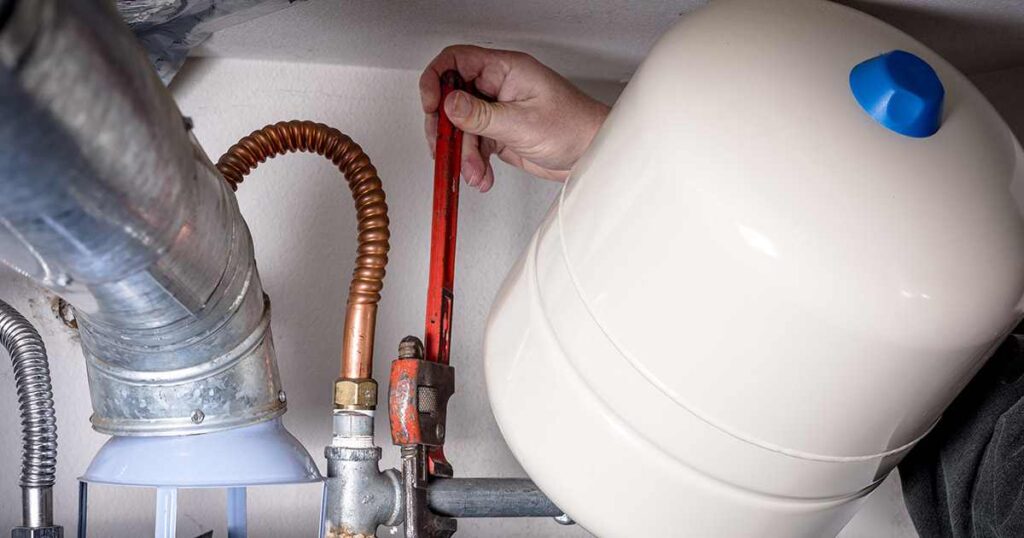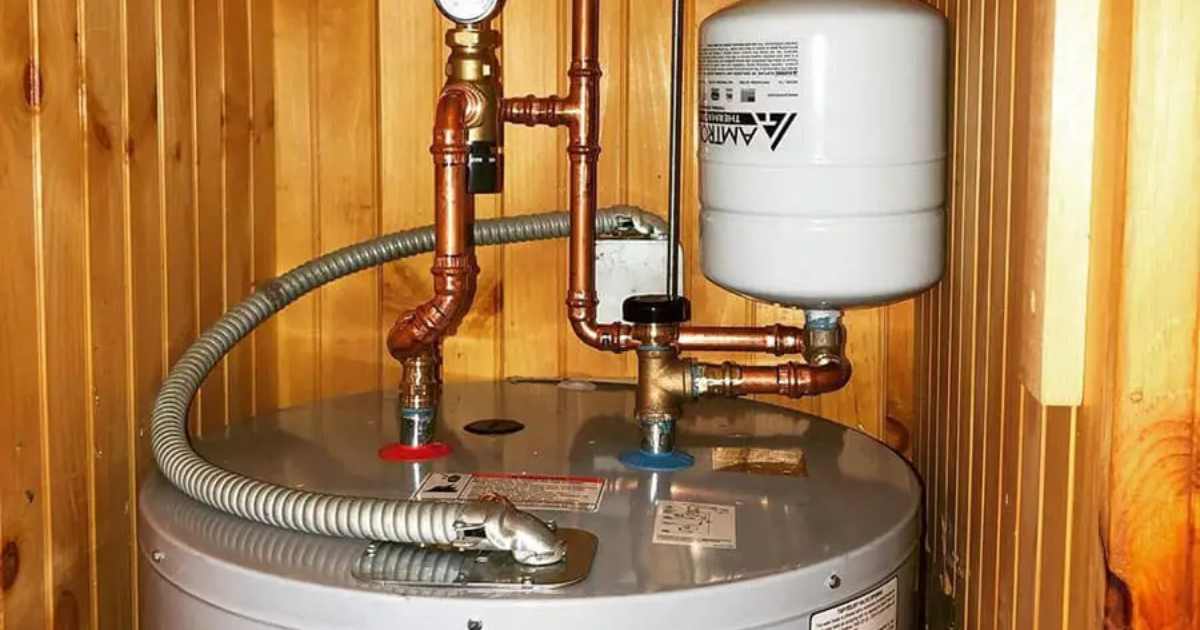A water heater expansion tank is a small tank that is connected to the water heater’s cold water inlet pipe. It helps to absorb the pressure caused by the expansion of water as it is heated. This prevents the pressure relief valve from opening and releasing water, which can waste water and energy.
Water heater expansion tanks are typically made of steel or brass and have a rubber diaphragm inside. The diaphragm separates the water from a pre-charged air chamber. As the water in the tank heats up, it expands and pushes against the diaphragm. This compresses the air in the chamber, which helps to absorb the pressure.
When the water cools down, the pressure in the tank decreases and the diaphragm relaxes. This allows the air in the chamber to expand, which helps to draw the water back into the tank. Water heater expansion tanks are an important part of a water heating system and help to prevent damage to the water heater and other plumbing components.
Understanding the Water Heater Expansion Tank: A Vital Component
When you’re heating a pot of water on the stove. As the water gets hotter, it expands, right? Well, the same thing happens inside your water heater. When the water heats up, it expands and needs somewhere to go. That’s where the water heater expansion tank comes in.
Think of the expansion tank like a little safety valve. It’s a small metal container connected to your water heater’s cold water inlet pipe. When the water expands, it moves into the expansion tank. This helps to relieve pressure inside the water heater and prevents it from exploding or leaking.
Without the expansion tank, all that extra pressure would have nowhere to go and could cause major damage to your water heater and plumbing system. So, the next time you take a hot shower, remember to thank your little friend, the water expansion tank.
The Science Behind Thermal Expansion Tank and Its Impact on Water Heaters

When you blow air into it, it gets bigger, right? That’s because air expands when it gets warmer. The same thing happens to water! When water is heated in your water heater, it expands in volume. This means it takes up more space, and that can cause problems.
Think of your water heater like a closed container full of water. As the water heats up, it starts to expand. But the container can’t get any bigger, so the pressure inside increases. This pressure can be dangerous if it gets too high, because it can cause the water heater to leak or even explode.
That’s where the water heater expansion tank comes in. This tank is like a safety valve for the pressure. As the water expands, it enters the expansion tank and compresses the air inside. This helps to reduce the pressure in the water heater and keep it safe.
How the Expansion Tank Absorbs Pressure and Prevents Leaks
As you fill it with water, it gets bigger and bigger, right? That’s kind of what happens to water in your hot water heater. When water is heated, it expands and occupies more room. This can cause a lot of pressure in the pipes, which is bad news.
That’s where the expansion tank comes in. It’s like a little safety valve for your hot water heater. It’s a small tank with a rubber bladder inside. As the water expands, it pushes against the bladder. This compresses the air inside the tank, which absorbs the pressure and keeps it from building up in the pipes.
Think of it like squeezing a stress ball. When you squeeze it, the air inside pushes back, right? That’s what the air in the expansion tank does. It pushes back against the water, keeping the pressure in check and preventing leaks.
Recognizing Signs of a Failing Expansion Tank and Necessary Replacements

Just like any other part of your home, your water heater expansion tank can wear out over time. It’s important to be aware of the signs that your expansion tank is failing so that you can take steps to replace it.
Common signs of a failing expansion tank include:
- Leaking water: If you notice water leaking from the tank, it’s a sign that the diaphragm has failed and the tank is no longer able to hold pressure.
- Low water pressure: If you experience low water pressure, it’s possible that the expansion tank is not able to absorb the pressure from the expanding water.
- Knocking noises: If you hear knocking noises coming from your water heater, it’s a sign that the air in the tank is no longer able to absorb the pressure.
- Frequent cycling: If your water heater is cycling on and off more frequently than usual, it’s a sign that the expansion tank is not able to keep up with the pressure changes.
If you experience any of these signs, it’s important to replace your expansion tank as soon as possible. Replacing a failing expansion tank is a relatively simple and inexpensive repair. Here are the steps involved in replacing an expansion tank:
Maintaining Your Expansion Tank for Optimal Performance and Longevity
Just like your bike needs regular tune-ups, your water heater’s expansion tank needs some TLC too. Keeping it in tip-top shape ensures smooth operation and prevents costly repairs down the road.
Here’s the good news: maintaining your expansion tank is super simple. Think of it like checking the air pressure in your bike tires. Every few months, grab a tire pressure gauge and check the air pressure in the pre-charged air chamber. It should be around 7psi, which is roughly the same as your car tire. If it’s low, don’t worry! Just use a regular bike pump to top it off.
Remember, a well-maintained expansion tank is a happy expansion tank. It will keep your water heater running smoothly and save you money in the long run. So, grab that gauge and give your tank a quick check-up today.
Comparing Types of Expansion Tanks: Choosing the Right One for Your System
There are two main types of water heater expansion tanks: bladder and diaphragm. Bladder tanks have a rubber bladder inside that separates the air and water. Diaphragm tanks have a flexible diaphragm that performs the same function. Both types work by absorbing the pressure caused by the expansion of water as it heats up.
The best type of expansion tank for your system will depend on a number of factors, including the size of your water heater, the type of plumbing system you have, and your budget. Bladder tanks are typically less expensive than diaphragm tanks, but they may not be as durable. Diaphragm tanks are more expensive, but they are more durable and can withstand higher pressures.
Here are some additional factors to consider when choosing an expansion tank:
- The volume of your water heater: The size of the expansion tank should be based on the volume of your water heater. A larger water heater will require a larger expansion tank.
- The type of plumbing system you have: If you have a closed-loop plumbing system, you will need a pre-charged expansion tank. If you have an open-loop system, you will need a non-pre-charged expansion tank.
- Your budget: Bladder tanks are typically less expensive than diaphragm tanks.
- Your climate: If you live in a climate with extreme temperatures, you may need a larger expansion tank.
Once you have considered all of these factors, you can choose the best type of expansion tank for your system. A qualified plumber can help you choose the right size and type of expansion tank for your needs.
DIY vs. Professional Installation: Weighing Your Options
Installing a water heater expansion tank is not the most challenging plumbing project, but it does require some basic plumbing skills. If you’re comfortable working with pipes and tools, DIY installation can be a cost-effective option. However, if you’re unsure of your abilities, it’s always best to call a professional plumber.
Here are some things to consider when deciding whether to install your expansion tank yourself or hire a professional:
DIY:
- Pros:
- Saves money on labor costs
- Provides a sense of accomplishment
- Gives you valuable plumbing experience
- Cons:
- Requires some plumbing knowledge and skills
- Risks potential leaks or damage if done incorrectly
- May not be covered by warranty if installed incorrectly
Professional:
- Pros:
- Ensures proper installation for safety and efficiency
- Offers peace of mind knowing the job is done right
- Saves time and effort
- Cons:
- Costs more than DIY installation
- May require scheduling an appointment
- May not be available on short notice
Ultimately, the decision of whether to DIY or hire a professional is up to you. Weigh the pros and cons of each option carefully before making a decision. If you’re unsure of your abilities, it’s always better to err on the side of caution and call a professional.
Ensuring the Safety and Efficiency of Your Water Heater with a Proper Expansion Tank

As the water heats up, it starts to expand and take up more space. If there’s no room for it to expand, the pressure can build up and cause the pot to burst! That’s where an expansion tank comes in. Think of it as a little extra space for the water to go when it expands.
It’s like adding another pot next to the first one so there’s plenty of room for both. This helps to keep the pressure from getting too high and prevents the water heater from exploding. But it’s not just about safety. An expansion tank also helps your water heater work more efficiently. Without one, the pressure relief valve might open and release hot water to relieve pressure.
This wastes water and energy, because the water heater has to work harder to heat up more water. So, an expansion tank is like a superhero for your water heater! It keeps it safe from exploding, helps it run more efficiently, and saves you money on your water and energy bills.
FAQ’s
Is an expansion tank necessary for a water heater?
Whether or not your water heater requires an expansion tank depends on its type. If you have a closed system (most modern homes), yes, you need an expansion tank.
What is a water heater expansion tank installation diagram?
A water heater expansion tank installation diagram is a visual guide that shows you how to install an expansion tank on your water heater. It includes information on the location of the expansion tank, the size of the tank, and the type of connections that are required.
How to install expansion tank on water heater?
Connect a dielectric union to the cold water inlet pipe of your water heater. Install a tee fitting and connect the expansion tank’s pipe to it.
Is an expansion tank for a water heater required by code?
Yes, most codes require an expansion tank for water heaters in closed systems, especially when backflow prevention devices are present.
Conclusion
So, what does a water heater expansion tank do in simple terms? It’s like a safety valve for your hot water hero, the water heater. Imagine your favorite balloon animal. When you blow air into it, it gets bigger and bigger, right? That’s kind of what happens to water when it gets heated. It expands and needs more space.
The expansion tank acts like a spare room for the expanding water. It absorbs the extra pressure and keeps things safe and sound. This prevents leaks, bursts, and even damage to your water heater. It’s like having a little helper watching over your hot water supply, ensuring it works smoothly and lasts for years to come.











